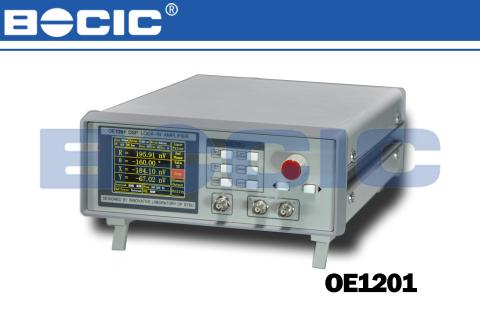OE1201 Digital Lock-In Amplifiers
Now OE1201 DSP Lock-In Amplifier is the newest productof core technology with high performance. Based on thehigh-speed 4-core architecture, high-precision stabilizedADC and excellent analog performance, it is ideal to detectthe weak signals, which are overwhelmed by greatly largernoise components. And OE1201 could measure themagnitude and phase of a signal simultaneously. It could becomparable with the international leading technology insome core parameters, like accuracy of measurement, rangeof operating frequency, SNR, dynamic reserve and so on.
- description
- parameters
Signal Channel
Voltage input Mode: Single-ended or Differential
Full-scale Sensitivity: 2 nV to 1 V in a 1-2-5 sequence
Current input: 10 or 10 V/A
Impedance:
Voltage: 10 MΩ // 25pF, AC or DC coupled
Current: 1kΩ to virtual ground
C.M.R.R: >100 dB to 10 KHz, decreasing by 6 dB/oct
Dynamic reserve: >100 dB
Gain accuracy 0.2% typ, 1% max
Noise :10nV/√Hz at 1 kHz
0.13pA/√Hz at 1 kHz
0.013pA/√Hz at 100 Hz
Line filters: 50/60 Hz and 100/120 Hz
Gounding: BNC shield can be grounded or floated via 1kΩ to ground
Reference Channel
Input:
Frequency range 50 mHz to 120 kHz
Reference input TTL or sine
Input impedance 1 MΩ//25 pF
Phase:
Resolution 0.01° increments
Absolute phase error <1°
Relative phase error <0.01°
Phase noise
Internal ref. Synthesized, <0.0001°rms at 1kHz
External ref. 0.005°rms at 1 kHz (100 ms time constant, 12 dB/oct)
Drift: <0.1°/℃ below 10 kHz
<0.5°/℃ above 10 kHz
Harmonic detection: 2F, 3F, …nF to 120kHz (n<32,767)
Acquisition time:
Internal Ref. Instantaneous acquisition
External Ref. (2 cycles + 5 ms) or 40 ms,whichever is larger
Demodulator
Stability:
Digital outputs no zero drift on all setting
Display no zero drift on all setting
Analog outputs <5 ppm/℃ for all dynamic reserve settings
Harmonic rejection: -90 dB
Time constants: 10μs to 3ks (<200Hz)
10μs to 30s (>200Hz)
(6, 12, 18, 24 dB/oct rolloff)
Synchronous filters: Available below 20 Hz
Internal Oscillator
Frequency:
Range 50 mHz to 120 kHz
Accuracy 25 ppm + 30 μHz
Resolution 1 mHz
Distortion: -80 dBc (f<10 kHz),
-70 dBc (f>10 kHz)
Amplitude: 0.10Vrms to 1 Vrms
Accuracy: 1%
Stability: 50 ppm/℃
Outputs: Sine, 50 Ω output impedance
Display
Screen: 3.5 inch, 320×240 TFT
Display quantities: 4 channels of data to display X,Y,R and θ
Display types: Large numeric readout
Outputs
CH1 and CH2 Outputs:
Function X, Y, R, θ
Amplitude ±5 V
Impedance 100 Ω
Interfaces
RS-232 and RS-232 to USB interfaces. All instrument functions can be controlled and read through USB interfaces.
General
Power requirements:
Voltage 220/240V AC
Frequency 50/60 Hz
Power 30 W
Dimensions:
Width 259 mm
Depth 320 mm
Height:
With feet 115 mm
Without feet 102 mm
Weight 3.2 KG









